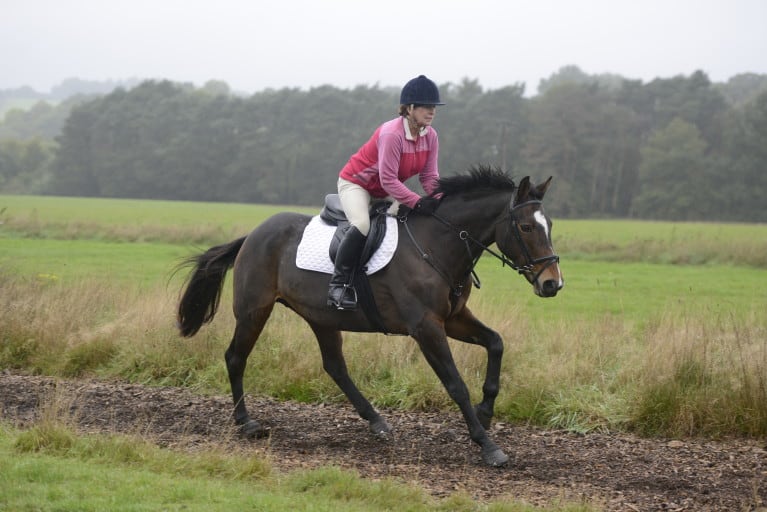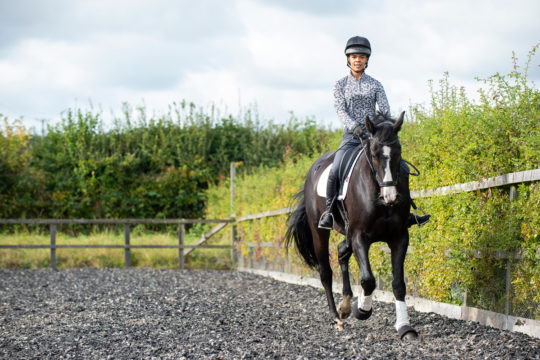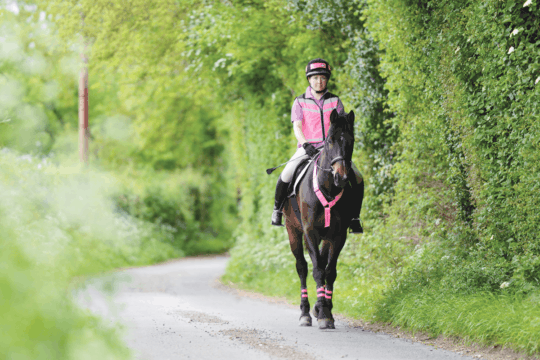Do you want to go fast, but worry you might not stop at the other end? Then follow Tina Sederholm’s great advice for staying in control

When I was eventing at top level, we’d take the horses to the racehorse gallops in Lambourn as part of their fittening programme.
I was allowed to gallop a lot of horses, because from a young age, I had the knack of being able to hold even very strong pullers. This was not so much a special talent, more that I cottoned on quickly to the techniques that can help a 10-stone human being control half a tonne of horse moving at speed.
How to hold a galloping horse
The main key to holding a horse is to maintain an effective position. To go into galloping position, spring out of the saddle, pushing the weight down on to the stirrup as you do it, keeping your lower leg at the girth. Your stirrups must be short enough (a minimum of two holes above your normal jumping length) for you to keep a springiness in your knees and ankles, to absorb the galloping movement. Keep your back long, your eyes forward and your elbows fairly close to your knees. Don’t lean on the horse’s neck, even though you’re resting your hands there.
It’s vital, when you are in the galloping position, that you stay in the centre of your horse and do not get in front of the movement. It is a delicate balance, but if you have the feeling that a lot of the horse is behind you, or that your chin is getting close to his ears, you are in front of the movement.
Tina says… “Pick the best possible ground to gallop on. Galloping on hard or boggy ground increases the risk of injury.”
Bridge your reins
In order to keep a steady contact, it is a good idea to bridge your reins. This means putting one rein over the top of the other, to form a small hoop about 10cms (4in) long, which you hold between your hands and which fits over the horse’s neck. Your hands will then be either side of the horse’s neck, just below the mane.
Bridging the reins, together with the ‘V’ frame that you form with your body, acts as an anchor if the horse pulls and runs away. If you keep your leg at the girth, your body still and your hands on the neck when the horse pulls, he only pulls against himself.
You may not feel entirely in control at this moment, but if you remain steady in your galloping position, the horse will soon relax and start to accept the control.
Tina says… “Vary the pace – sometimes do a gentle canter, other times go faster – as this stops your horse anticipating the speed.”
Starting off
Watch any experienced rider leaving the start box of a cross-country course, and you’ll see that they do not start in a forward position. Instead, they sit lightly and let him jump out of the start box on a semi-loose rein, only going into a galloping position and gathering up the reins after a few strides. This way the horse is in front of their aids. If you start by grabbing hold of his head, he’ll think how he can get away from you. So when you start off on a gallop, copy this idea of letting the horse jump forward on a semi-loose rein, before springing up into position and bridging your reins.
Note, though, that you would not bridge your reins when you are going cross-country, as this makes it difficult to organise for the fences. However, you can still keep your hands on the horse’s neck, pressing the joints of your fingers into it if he’s pulling hard, as a substitute for bridging.
Pulling up
Always pull up on a straight line. Turning and pulling up at the same time substantially increases the risk of injury, and also does nothing for your horse’s discipline. As you come to the end of your gallop, slowly let your reins slide through your hands, your legs straighten and your upper body become vertical. The release of pressure on the horse’s mouth will cause him to slow down.
If he does not slow down, anchor one hand on the neck, still letting the rein slide a bit, and take checks with the other. Be careful not to swing him about. The idea is to keep him straight, so that he stays balanced as you influence to decrease speed. As soon as the horse wants to stretch his head and neck down, let him.
Training your position
Get your body, particularly your muscles, used to being in the galloping position before you set off at speed.
Practising to bridge your reins and stand up in the stirrups in trot is good for your general fitness and for the horse, especially when going up hills. Having your weight off his back when he is working hard gives him room to swing his back muscles. Then, when you come back to rising trot, he’ll be able to carry you more easily.
Work in pairs or groups
It’s more fun to go out in a pair or a group to do conditioning work. But the group needs to agree about rules of behaviour, or it can be mayhem! This is no fun for you and increases the risk of injury to your horse. When you go out in a pair, stick stirrup-to-stirrup. The rider on the left dictates the pace and the line, and the rider on the right does their best to keep up.
Tina says… “It can be more fun to go out in pairs or groups, but agree about rules first.”
There’s always room for negotiation and it’s up to the rider on the left to be fair to the rider on the right. However, this way both you and the horses know where you stand. The horses, even if they start a bit fresh and sharp, will settle because there are obvious boundaries to their behaviour. If you’re in a group of three, then you can try three abreast, but if there are any more, stick to pairs.
Your Comments
2 thoughts on “How to hold a galloping horse”
Leave a Reply
You must be logged in to post a comment.












Hi there, I’ve just got a job track riding in the racing industry. I’ve been riding for 8 years and had no trouble pulling up and controlling horses however starting the racing industry I’ve had trouble controlling pulling / strong horses. It’s been 2 months and still I can’t seem to slow them down! It’s very frustrating as my boss gets disappointed, he doesn’t give me any helpful tips, I know that pulling the reins too hard will make the horse go faster so I soften my grip but the horse still seems to go faster, please help!!
Hey there! I just started myself! They say that if you take a cross in your left hand 3/4 down the neck and then your right hand rests 1/2 way just above your other hand at a jog it will help them relax instead of fighting right off the bat! The half cross will make it easier to pick up a full cross with just the thumb of your left hand! pinky fingers need to be outside of the rein for a better grip, use your thumbs to loop over the horses mane line if you really need to hold, heels down and put your weight back. I’m not saying this will help you hold a fire breather but it has helped me tremendously! What it does for you is the hand that is in the middle of their neck can get their nose from them while the lower hand, if needed at all will be a reinforcement if the horse is strong. Squeeze your knees together in toward the saddle and relax your weight so that you will be able to feel them and they will feel you as well. If you’re tight, they’re tight so just relax and take a deep breath, hold your hands steady and if they really get to pulling take that full cross and slide it down their neck so that they pull on themselves even more but don’t choke them too hard, they’ll get stronger! Just give it a shot!